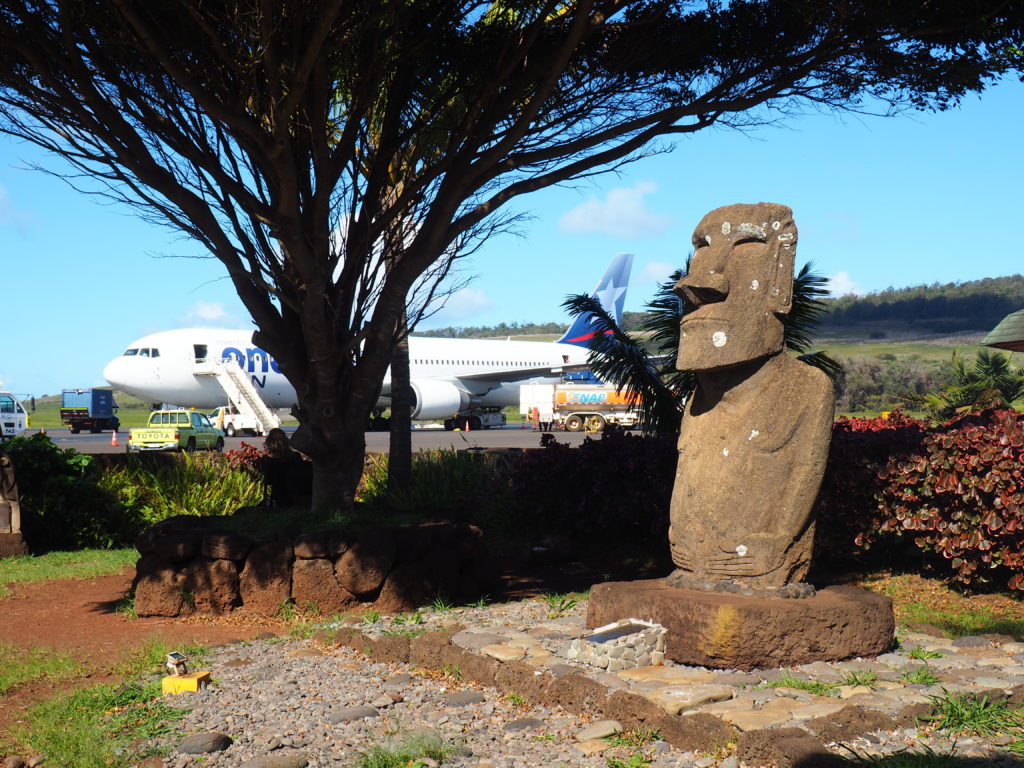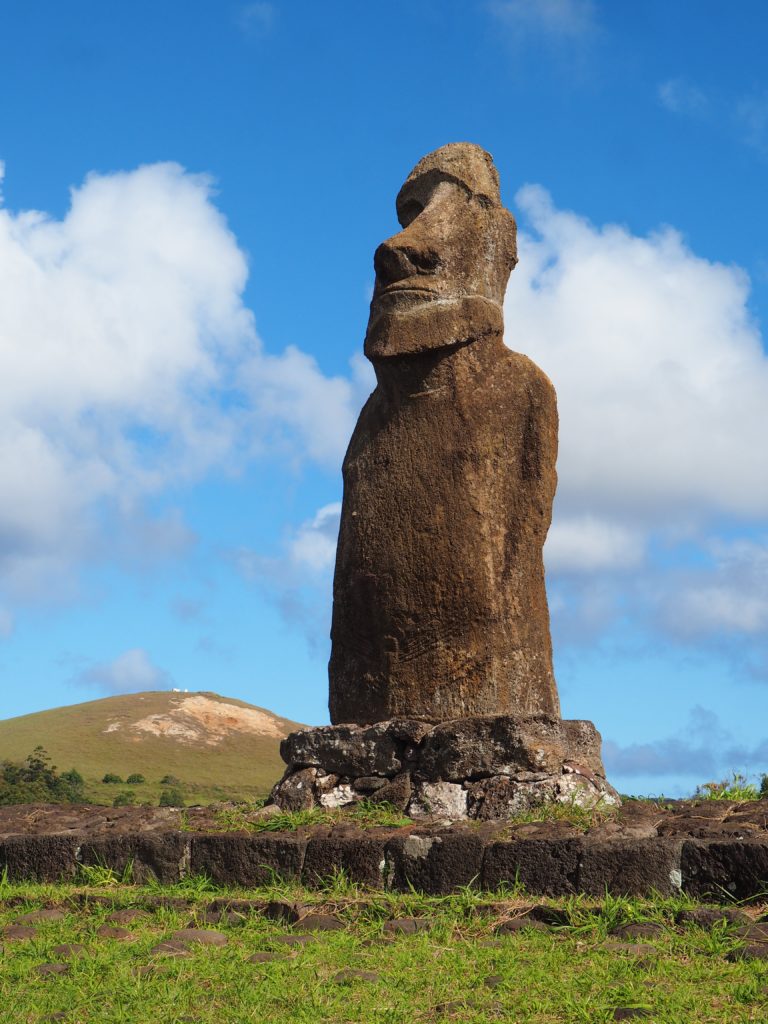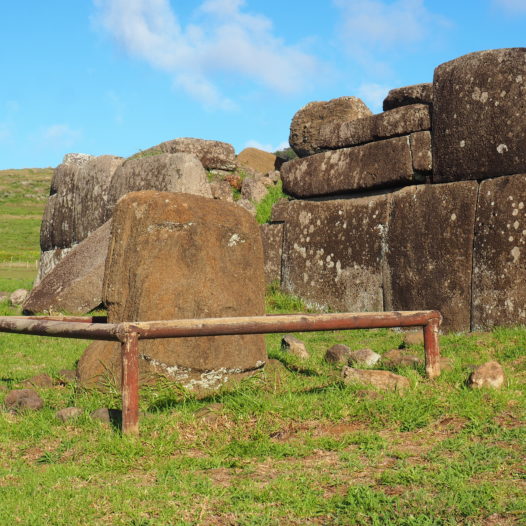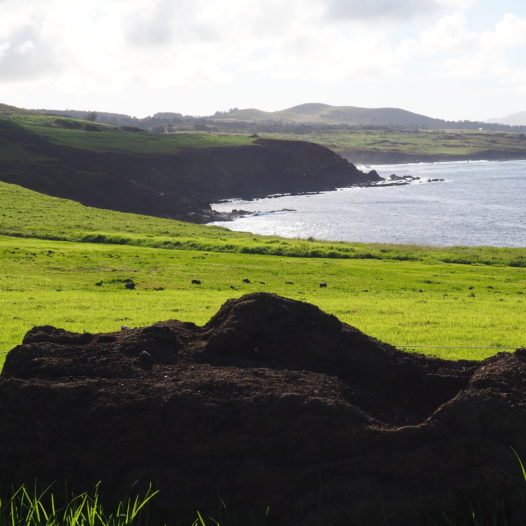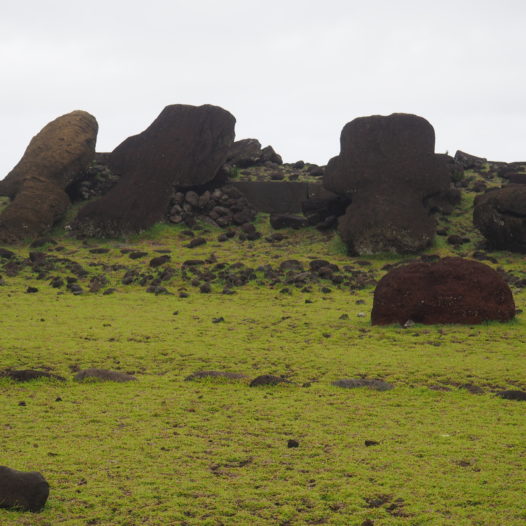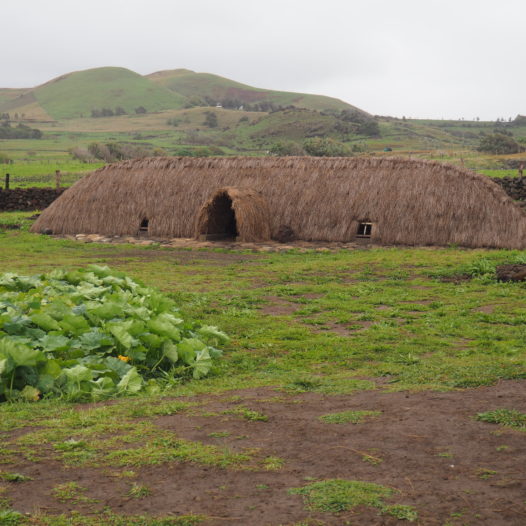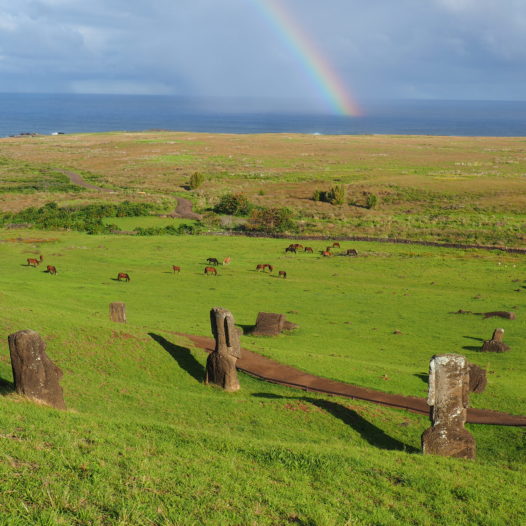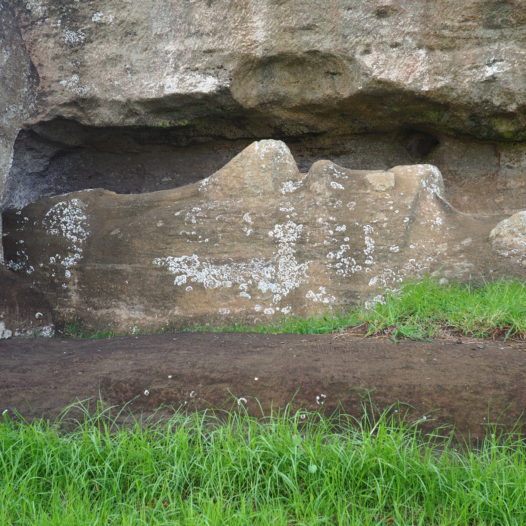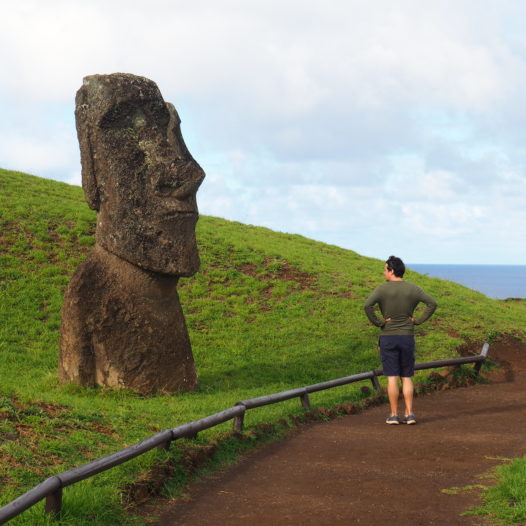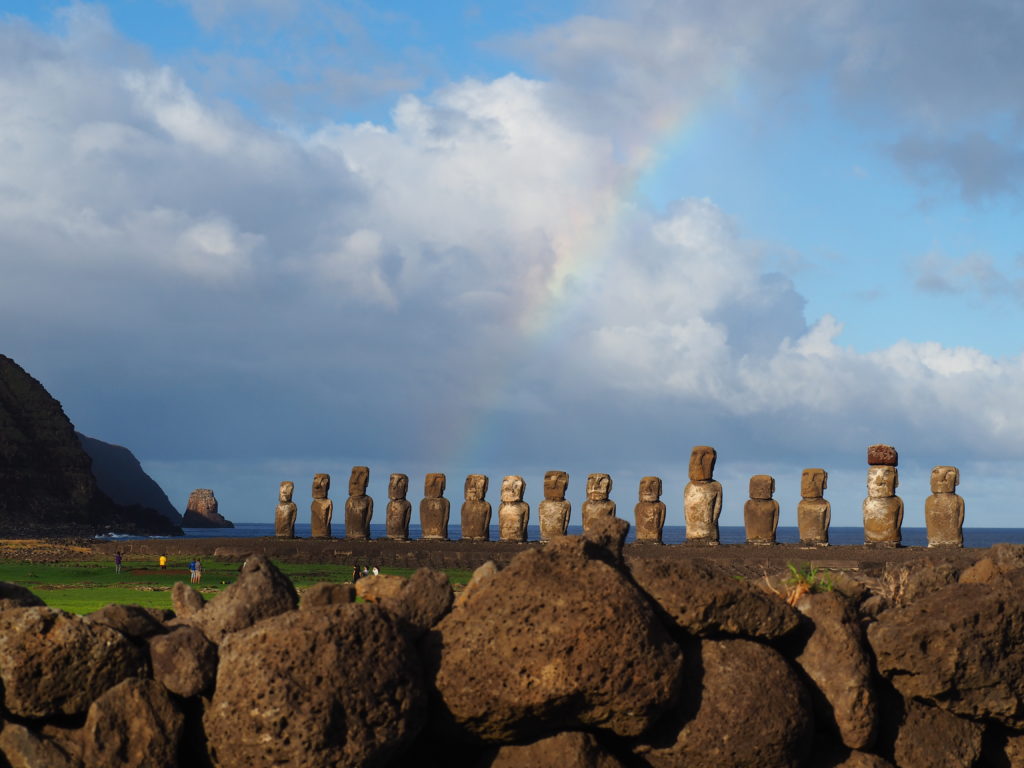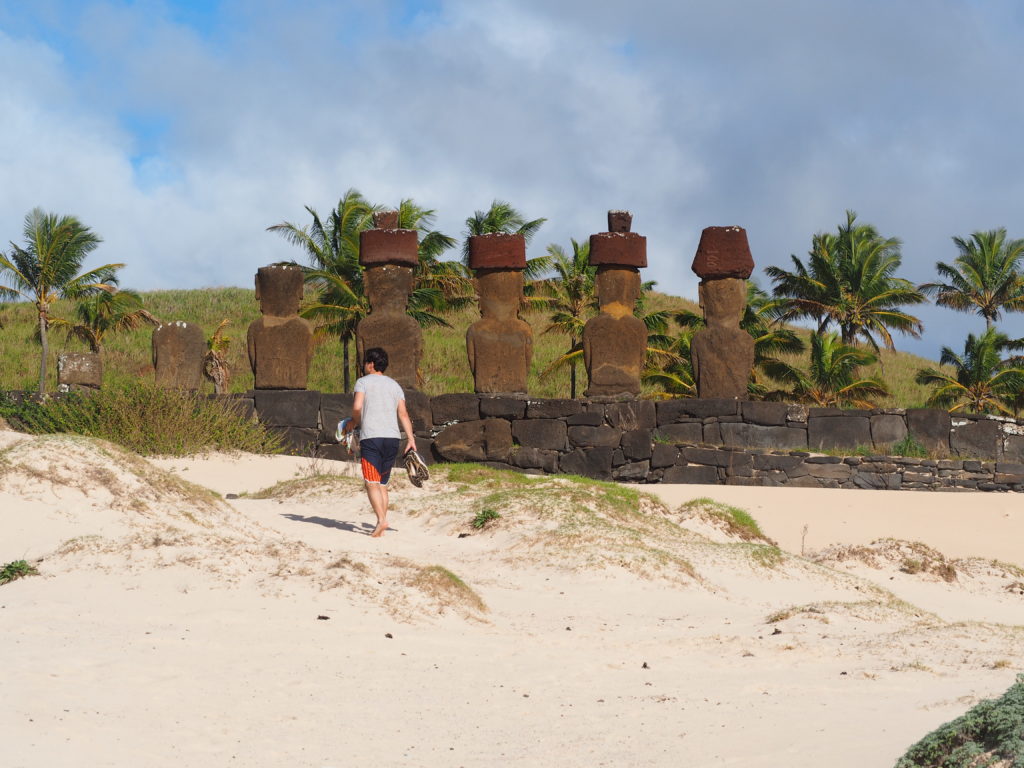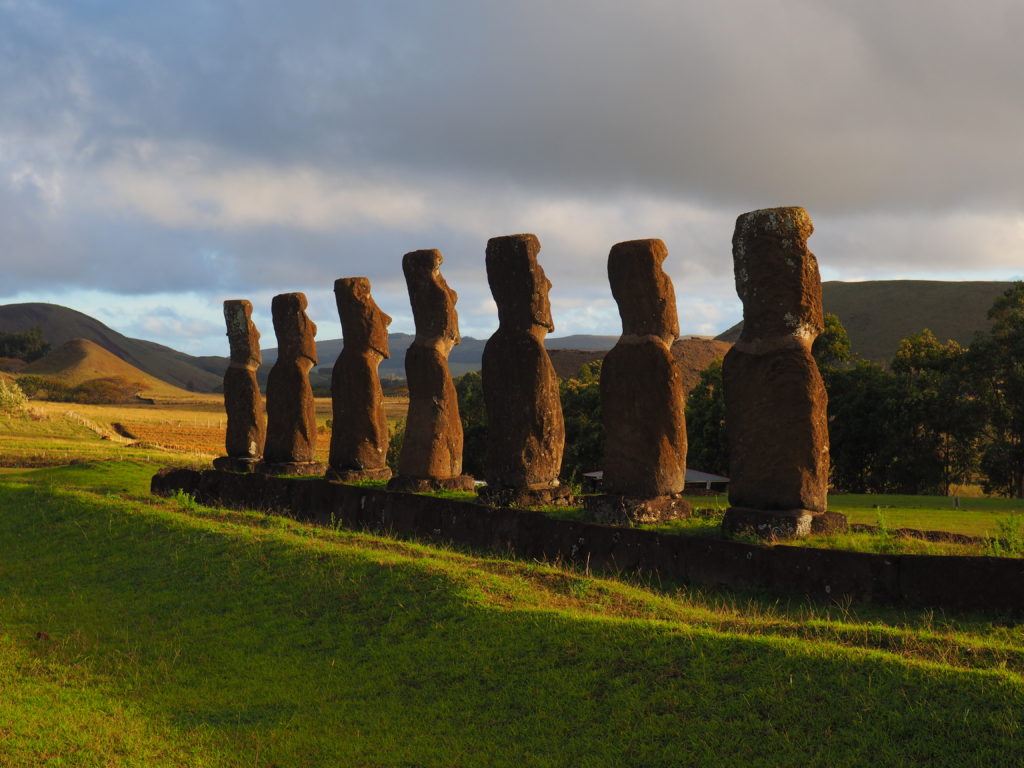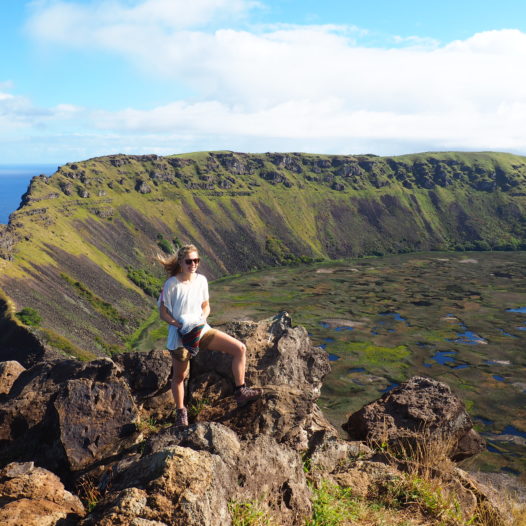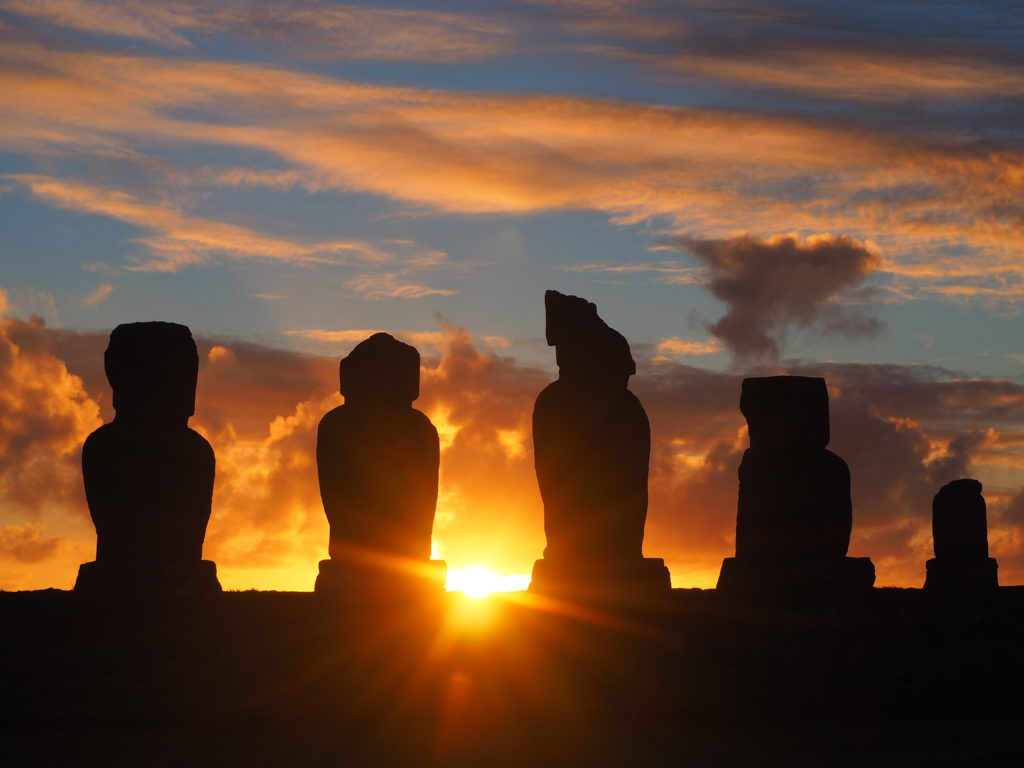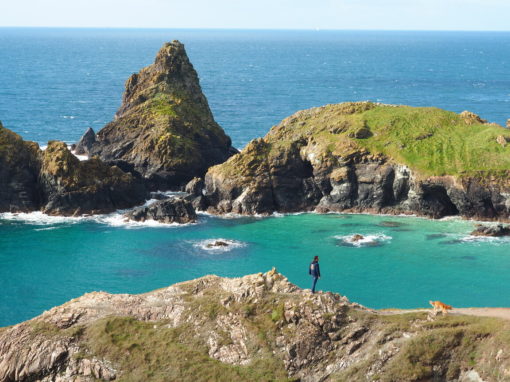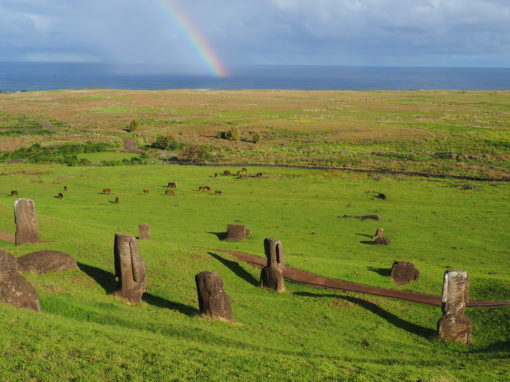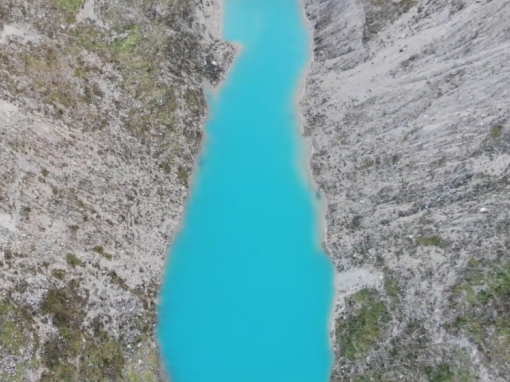Planning a stunning trip to the insanely remote island of Rapa Nui? Splendid choice! Although you can see all of the island (if you’re in a hurry and willing to rent a car for the most of your time) within a day or three, I would recommend a stay of at least 5 days on the island. You might never come back to this special Polynesian spot and there’s a severe chance of rainfall on the island, no matter the season. So count in some extra time to avoid disappointment.
In case you want to do the trip on a budget, for this itinerary you only need to rent a car for ONE day! You’re welcome.
Want to get a taste of Rapa Nui, see my best photos of our 5-day trip in here!
Day 1: El Museo Antropológico Padre Sebastián Englert / Settling in / Shopping / Get that Rapa Nui stamp / Sunset at Tahai
9 am – Arrival
Assuming that you arrive with the morning flight from Santiago de Chile and you were able to sleep a little bit, it’s still possible to do a lot of stuff on your first day. Hurray!
In fact, you can already see a moai at the airport!
10 am – Museum time
But let’s take it easy. After dropping your luggage and checking in, first head to El Museo Antropológico Padre Sebastián Englert. The building is a small hike from town (some 20 – 30 minutes from the main street by foot) and it’s only opened in the morning. It’s closed on Mondays, but check beforehand your visit just in case.
I personally really loved the museum. It’s small, but it gives you a good overview about the life on Rapa Nui, its history, different clans, traditions and the research so far regarding the famous moai statues. Therefore it’s a great place to start your trip as it puts everything into place and perspective.
There are some really interesting pieces and beautifully carved tools to be found in here too. Also, this is the only place where you can see a female moai! Those are so different from the ones we know and she’s totally awesome. I didn’t picture her, so no spoilers in here
It takes about an hour to read all of the information in the museum and entrance it’s free for everyone!
12 am – Explore the town
After this introduction you can use the rest of the day to explore the cute, little town of Hanga Roa. Especially the street of Atamu Tekena is worth a mention. Galleries, little shops, some supermarkets, gelaterías, cheap tuna empanadas, bakeries; everything you need to get you going you can find in here.
Near the little square at the end of the street you can also find a small craftsmen area, the best place for souvenir hunting.
3:30 pm – Stamp it up
After you’ve found your perfect moai souvenir, make sure to stop by the post office at the Te Pito o Te Henua street. Why? Well, you don’t want to miss out on an cool-looking Rapa Nui stamp in your pasport, now do you? It’s free too :). Note that the office has an hour long break around lunchtime! If you happen to run out of time for a visit, it’s also possible to get the stamp on the little craftsmen market, but that’ll cost you $3,- USD.
5:30 pm – sunset at Ahu Tahai
At the end of the day, make sure you don’t miss the sunset at Ahu Tahai. The moai of Tahai are located right on the coast, fairly near town. It takes a 20 minute walk from the most northern end of main street to get there. The Ahu Tahai group is not part of the Rapa Nui National Park, so you can enter the area for free!
The area contains three ceremonial platforms – Ko Te Riku, Tahai and Vai Ure, with a total of 7 moai. Moai Ko Te Riku is a little unique, as its eyes have been restored by an American archeologist.
Friendly horses and dogs roam free around the statues. But it’s not just the scenic setting why you should visit this place. If you want to make it worthy then you MUST go to Tahai around sunset.
You won’t be the only one visiting the spot around this time. In fact, I guess visiting Tahai is basically the # 1 activity on this island around sunset.
7 pm – Dinner time
Not in the mood for cooking? Go to Te Moana for the best tuna ceviche in town to wrap up your first day!
Day 2: Cruising around the island: the highlight day
This is the day that you need to rent a car, in order to visit all of the best spots of the National Park of Rapa Nui. Pick it right, this day will be of no fun when it’s raining. Also keep in mind that you need to buy the National Park ticket to visit the most of the ahu and their moai during this day.
Apart from that; just drive. All along the shores of Easter Island you can see groups of the famous moai standing fiercely in the sun. Most of the time they’re facing the hills, showing their backs to the sea, as a way of protecting the island.
Almost all of the coastal line of Rapa Nui (which is the original name of Easter Island) is rocky and rough, with pieces of land that wouldn’t misfit the coast of Ireland. Therefore the moai often just disappear in the pitch black background. Thus don’t think it’s always easy to spot them. This is especially true because many moai have been toppled during the tribal wars.
If you want to see them all, you really have to stay focused while driving around. The app maps.me has marked them all for example, but even if you’re standing next to one you’re still not sure if you have crossed of a new statue from your list. “Would that be one?” you hear yourself wondering quite often.
These ones below are marked by the national park itself and are all easily to find!
08:30 am – The lonely moai
Start your day while driving out of town with your first – and huge – moai on the road of Pia Taro. It feels like he’s kind of neglected, as you just kind of have to notice him by accident. But he’s out there and the area is open to visitors, so don’t be shy and bring him a visit!
9 am – Vinapu
As the sites of the national park open at 9am, the moai of Vinapu are a perfect first stop as they’re not too far from town.
The moai are swept from their feet at this spot, but because of their backdrop it’s still a fascinating place and worthwhile to visit. Not only are the views on the rugged coastline – the one you’ll drive today – absolutely stunning, the moai are also situated near a very thick wall, probably their former ahu. The large stones fit perfectly into one another, which is really remarkable.
As I’d just been to Machu Picchu they reminded me very much of the inca buildings over there. I later on read that the Polynesians didn’t do stonework at all, except at Easter Island. This is one of the reasons that Thor Heyerdahl thought the first inhabitants of this island were from South America, rather than Polynesia.
9:30 am – Vaipu / Hanga Te’e
It’s kind of difficult to spot these moai on the eastern road, as they have fallen down flat on their noses. We knew they were supposed to be there somewhere, but it took us two visits before we could finally spot them. Like most of the moai on the island these moai were tumbled during the tribal wars on Rapa Nui.
It’s kind of a sad view though, to see them all laying so helpless on the ground. Even the red hats / topknots (named ‘pukao’) are still around.
Close to the site there’s a (newly structured) house that shows its visitors how the people of Rapa Nui used to live. Fun to have a look at, while you’re there!
10:30 am – Rano Raraku
A little bit to the left of the eastern coastal road you can find Rano Raraku – a remarkable place on Easter Island. I mean, the island itself already is extraordinary, but as you enter the quarry of where it all began – that is, where all of the moai carving on this island took place – it’s like you’ve entered another world.
Hundreds of moai didn’t make it that far from from their birthplace and are all just frozen in time, within and outside of this old volcano crater.
While driving towards the area you can already see lot of heads sticking out of the ground on the slope of the hill. So bizar. An exact 397 moai are to be found in here, scattered all over the place. That’s almost the half of the 884 (so far discovered) moai. Quite a lot!
Read more about Rano Raraku in here!
12:30 pm – Tongariki
Look at that; the largest platform of moai on the island! And perhaps the most photographed one of them all too. From Rano Raraku you already have a beautiful view on this moai collection, but as you drive to the north of the island the view only gets better.
The moai of Tongariki all were toppled during the civil war (started by the tribes due to a lack of resources). Its base (the ahu) was swept away after a tsunami on top of that.
But with a little help of a Japanese crane company they’re back on their feet nowadays.
1:30 pm – Petroglifos Papa Vaka
Papa Vaka is a small site on the northern coast of the island. You can see all of its petroglyphs within a couple of minutes, but the site is interesting nonetheless.
It’s fun to recognize the figures engraved in the big rocks, although some of them require a bit of an explanation. It’s a peaceful place and you might just have it all to yourself.
2 pm – Te Pito Kura
At the next spot in the north you can find the largest moai statue of the island! At least the largest one that had been freed from to the volcano quarry of Rano Rarako. And it was transported too all the way to its ahu.
Unfortunately it was pushed down as well, some two centuries ago. The sign near the statue say a widow ordered this moai to commemorate her late husband. Apart from this lovely story its dimensions are just spectacular: the ears alone measure 2 meters, its height reaches 10 meters and it is estimated that its weight must exceed 80 tons.
3 pm – Anakena
All of the moai are special of course, but Ahu Nau Nau and Ahu Ature Huki in particular won the lottery. I mean, just look at the location of these moai.
In the north an inland bay just pops up out of the blue along with its golden sand, a gorgeous coconut grove, crystal clear water, calm waves and free ranging horses in the grassy hills. Such a welcoming place.
According to the stories this is the spot where the first king Hotu Matu’a disembarked around 700-1000 AD. So Anakena basically represents the start of the Rapa Nui culture. Knowing all of this while laying on Anakena beach with those impressive moai behind you – built as a tribute to the first arrival on the island – is quite an experience for sure.
Read more about Anakena beach in here!
4:30 pm – Puna Pau
So by now you must have noticed that many of the moai are wearing ‘hats’ or ‘topknots’. These redbrick ‘pukao’ come the quarry of Puna Pau. This one may not be as spectacular as Rano Raraku, but it’s an important one as to have a complete idea on the completion of the moai. The quarry located on two hillsides that provide a cool look panorama on Hanga Roa too.
5:30 pm – Ahu Akivi
End of the day – last stop!
The statues of Akivi are said to represent the seven Polynesian explorers who found the island. These are now mainly known as the only moai that are facing the sea. Estimations are that they were created in the 15th century and put in that sea-facing postion in order to frighten any possible conquerors. Also interesting to know might be that these moai were the first ones that were restored and re-erected on their spot in 1960, by the American archeologist William Mulloy.
The view on the ocean is wonderful. Not as perfect as the backdrop of other moai (Tongariki for example), but the setting still is very amazing, especially around sunset, when the moai face the last warming rays as you can see in the picture below. So end your day over here for sure and enjoy the last bit of sunshine!
Day 3: Rano Kau hike / Orongo museum / The cave of Ana Kai Tanata
8 am – Rano Kau
All the way at its most southern tip, you can find the most beautiful caldera of Easter Island: Rano Kau. Calderas are always something special, but the one in here is just thrilling.
Rano Kau is the highest volcano of the island (of 3 in total) and luckily extinct, since quite a long time. The last eruption blew off the top of the cone, leaving room overtime for a deep freshwater lake, full of vegetation. As the crater rim has crumbled down a bit, you can have a stunning view from the mirador (viewing point of the crater) on the bright blue ocean right behind it.
The crater is arguably the most spectacular natural sight on the island and worth a couple of hours of your time. As the panoramas on both the island and the are superb all around the crater, prepare yourself for a big hike today.
You can start either in the village or a the crater rim (if you succeed to hitchhike :)).
1 pm – Orongo
If you want to learn more about the bird competition, head over to the small museum on the western side of the crater. Boards with information and a small maquette explain the history of the birdman ceremonies, the life in the villages and how the people of Rapa Nui lived before the first western explorers (and along with them later on the diseases and the like) came in sight in 1722.
After soaking up all of the information, it’s an easy stroll around the ancient village of Orongo next to the museum. This was were the ceremonial part of the birdman contest took place. It’s small, but interesting to see how the houses of the ancient Rapa Nui culture.
4 pm – The cave of Ana Kai Tanata
After your visit you need to descend the volcano again, towards the little town. Once you nearly reach Hanga Roa, make a quick stop at Ana Kai Tanata – a cave along the coast. The site isn’t big, but the paintings inside the gave are worth seeing for a second.
Day 4: Snorkeling in the morning / hiking to the lava caves / sunset at Tahai
9 am – The sunken Moai
Some 20 meters below the surface in front of the bay of Hanga Roa you’ll find another peculiar statue: at the bottom of the ocean! Although again this is not an authentic statue carved by the ancient Rapa Nui people, its location is so mysterious that it needs a mention in this list anyway.
The moai was made for the Chilean television show Iorana, in the ’90s. A diver later filled the statue with cement and sunk it to the bottom of the ocean. All diving centers can take you there if you’re up for an eerie underwater moment and most of them offers their first tours at 9 am!
12 pm – The lava tunnels
Time for a bit of hiking! Bring a sandwich or tuna empanada and walk past the Ahu Tahai to the north along the coast. The trail in itself is already beautiful with grazing horses and cows and steep cliffs, but the reason why you’re walking here is because of the lava tunnels that meandering through the earth beneath your feet.
After some 45 minutes you’ll encounter a sign that says ‘Ana Kakenga‘. Enter the area and walk towards a very small hole some 50 meters in front of it. This is it! If you don’t like small spaces this might not be your spot, but try to conquer your fears as the descent is really worth it. The hole is so small you have to remove your bag from your back before entering. Bring a flashlight or your cellphone, because the first bit of the underground part of this tunnel (some 10 meters) is quite dark and narrow.
After that bit the cave widens out and as you walk through the volcanic tube, you can see the two big holes from where the lava used to flow into the sea, really insane!
6 pm – Sunset at Tahai
What better way to end your stay with another epic sunset. I recommended you to come to Tahai on your first day and to close the circle of your stay on the island I would come again to this place on your last day. Just do it, there’s no way you’ll regret it.

